Abstract
In our research, we studied the regulatory effect of miR-29c-3p on HNSCC progression. First, bioinformatics approach was utilized to find significantly differentially expressed genes in The Cancer Genome Atlas-HNSCC. Then the target miRNA and its target mRNA were screened out. Next, qRT-PCR was utilized to examine miR-29c-3p expression in HNSCC and the adjacent tissue. Western blot was introduced to test the protein level of C1QTNF6. Besides, the results of MTT, wound healing, transwell and angiogenesis assays verified the proliferation, migration, invasion and angiogenesis of HNSCC cells. Finally, the targeted relationship of miR-29c-3p and C1QTNF6 was confirmed through dual-luciferase assay. Our study found the negative correlation of miR-29c-3p and C1QTNF6 in HNSCC. Besides, overexpressed miR-29c-3p suppressed proliferation, migration, invasion, and angiogenesis of HNSCC cells. Additionally, overexpressed C1QTNF6 facilitated these biological functions of HNSCC cells while upregulating miR-29c-3p reversed such effect. Altogether, miR-29c-3p was proven to suppress the tumor-promoting effects and angiogenesis in HNSCC by targeting C1QTNF6. We also revealed a novel mechanism of HNSCC progression. MiR-29c-3p/C1QTNF6 might be a target in HNSCC treatment.




Similar content being viewed by others
References
McDermott, J. D., & Bowles, D. W. (2019). Epidemiology of head and neck squamous cell carcinomas: Impact on staging and prevention strategies. Current Treatment Options in Oncology, 20, 43. https://doi.org/10.1007/s11864-019-0650-5
Gillison, M. L., et al. (2008). Distinct risk factor profiles for human papillomavirus type 16-positive and human papillomavirus type 16-negative head and neck cancers. Journal of the National Cancer Institute, 100, 407–420. https://doi.org/10.1093/jnci/djn025
Rettig, E. M., & D’Souza, G. (2015). Epidemiology of head and neck cancer. Surgical Oncology Clinics of North America, 24, 379–396. https://doi.org/10.1016/j.soc.2015.03.001
Takes, R. P., et al. (2012). Distant metastases from head and neck squamous cell carcinoma Part I. Basic aspects. Oral Oncology, 48, 775–779. https://doi.org/10.1016/j.oraloncology.2012.03.013
Sinha, P., et al. (2014). Distant metastasis in p16-positive oropharyngeal squamous cell carcinoma: A critical analysis of patterns and outcomes. Oral Oncology, 50, 45–51. https://doi.org/10.1016/j.oraloncology.2013.10.007
Bauer, E., et al. (2020). Extranodal extension is a strong prognosticator in HPV-positive oropharyngeal squamous cell carcinoma. The Laryngoscope, 130, 939–945. https://doi.org/10.1002/lary.28059
Sato, S., et al. (2019). EPHB2 carried on small extracellular vesicles induces tumor angiogenesis via activation of ephrin reverse signaling. JCI Insight. https://doi.org/10.1172/jci.insight.132447
Carmeliet, P., & Jain, R. K. (2000). Angiogenesis in cancer and other diseases. Nature, 407, 249–257. https://doi.org/10.1038/35025220
Bagnasco, L., et al. (2012). Role of angiogenesis inhibitors in colorectal cancer: Sensitive and insensitive tumors. Current Cancer Drug Targets, 12, 303–315. https://doi.org/10.2174/156800912800190929
Irimie-Aghiorghiesei, A. I., et al. (2019). Prognostic value of MiR-21: An updated meta-analysis in head and neck squamous cell carcinoma (HNSCC). Journal of Clinical Medicine. https://doi.org/10.3390/jcm8122041
Wang, Y., et al. (2017). MiR-34a suppresses HNSCC growth through modulating cell cycle arrest and senescence. Neoplasma, 64, 543–553. https://doi.org/10.4149/neo_2017_408
Vahabi, M., et al. (2019). miR-96-5p targets PTEN expression affecting radio-chemosensitivity of HNSCC cells. Journal of Experimental & Clinical Cancer Research, 38, 141. https://doi.org/10.1186/s13046-019-1119-x
Kolenda, T., Guglas, K., Teresiak, A., Blizniak, R., & Lamperska, K. (2019). Low let-7d and high miR-205 expression levels positively influence HNSCC patient outcome. Journal of Biomedical Science, 26, 17. https://doi.org/10.1186/s12929-019-0511-3
Hayes, J., Peruzzi, P. P., & Lawler, S. (2014). MicroRNAs in cancer: Biomarkers, functions and therapy. Trends in Molecular Medicine, 20, 460–469. https://doi.org/10.1016/j.molmed.2014.06.005
Garzon, R., Marcucci, G., & Croce, C. M. (2010). Targeting microRNAs in cancer: Rationale, strategies and challenges. Nature Reviews. Drug Discovery, 9, 775–789. https://doi.org/10.1038/nrd3179
Kinoshita, T., et al. (2013). Tumour-suppressive microRNA-29s inhibit cancer cell migration and invasion by targeting laminin-integrin signalling in head and neck squamous cell carcinoma. British Journal of Cancer, 109, 2636–2645. https://doi.org/10.1038/bjc.2013.607
Li, Y., et al. (2020). TUG1 enhances high glucose-impaired endothelial progenitor cell function via miR-29c-3p/PDGF-BB/Wnt signaling. Stem Cell Research & Therapy, 11, 441. https://doi.org/10.1186/s13287-020-01958-3
Chen, C., et al. (2020). The circular RNA 001971/miR-29c-3p axis modulates colorectal cancer growth, metastasis, and angiogenesis through VEGFA. Journal of Experimental & Clinical Cancer Research, 39, 91. https://doi.org/10.1186/s13046-020-01594-y
Lee, W., Kim, M. J., Park, E. J., Choi, Y. J., & Park, S. Y. (2010). C1qTNF-related protein-6 mediates fatty acid oxidation via the activation of the AMP-activated protein kinase. FEBS Letters, 584, 968–972. https://doi.org/10.1016/j.febslet.2010.01.040
Wong, G. W., et al. (2008). Molecular, biochemical and functional characterizations of C1q/TNF family members: Adipose-tissue-selective expression patterns, regulation by PPAR-gamma agonist, cysteine-mediated oligomerizations, combinatorial associations and metabolic functions. The Biochemical Journal, 416, 161–177. https://doi.org/10.1042/BJ20081240
Murayama, M. A., et al. (2015). CTRP6 is an endogenous complement regulator that can effectively treat induced arthritis. Nature Communications, 6, 8483. https://doi.org/10.1038/ncomms9483
Qu, H. X., et al. (2019). C1QTNF6 is overexpressed in gastric carcinoma and contributes to the proliferation and migration of gastric carcinoma cells. International Journal of Molecular Medicine, 43, 621–629. https://doi.org/10.3892/ijmm.2018.3978
Wang, L., Liu, Z., Duan, L., Ma, B., & Sun, Z. (2015). C1q tumor necrosis factor-related protein 6 (CTRP6) inhibits the proliferation and migration of ovarian cancer cells. Xi Bao Yu Fen Zi Mian Yi Xue Za Zhi, 31, 1664–1668.
Wang, H., et al. (2020). MiR-29c-3p suppresses the migration, invasion and cell cycle in esophageal carcinoma via CCNA2/p53 axis. Frontiers in Bioengineering and Biotechnology, 8, 75. https://doi.org/10.3389/fbioe.2020.00075
Wang, Y., Liu, G., Ren, L., Wang, K., & Liu, A. (2019). Long non-coding RNA TUG1 recruits miR29c3p from its target gene RGS1 to promote proliferation and metastasis of melanoma cells. International Journal of Oncology, 54, 1317–1326. https://doi.org/10.3892/ijo.2019.4699
Carmeliet, P., & Jain, R. K. (2011). Molecular mechanisms and clinical applications of angiogenesis. Nature, 473, 298–307. https://doi.org/10.1038/nature10144
Guo, L. M., et al. (2018). MiR-135a-5p represses proliferation of HNSCC by targeting HOXA10. Cancer Biology & Therapy, 19, 973–983. https://doi.org/10.1080/15384047.2018.1450112
Fang, R., Huang, Y., Xie, J., Zhang, J., & Ji, X. (2019). Downregulation of miR-29c-3p is associated with a poor prognosis in patients with laryngeal squamous cell carcinoma. Diagnostic Pathology, 14, 109. https://doi.org/10.1186/s13000-019-0893-2
Han, M., Wang, B., Zhu, M., & Zhang, Y. (2019). C1QTNF6 as a novel biomarker regulates cellular behaviors in A549 cells and exacerbates the outcome of lung adenocarcinoma patients. In Vitro Cellular & Developmental Biology Animal, 55, 614–621. https://doi.org/10.1007/s11626-019-00377-w
Takeuchi, T., Adachi, Y., & Nagayama, T. (2011). Expression of a secretory protein C1qTNF6, a C1qTNF family member, in hepatocellular carcinoma. Analytical Cellular Pathology (Amsterdam), 34, 113–121. https://doi.org/10.3233/ACP-2011-009
Wan, X., Zheng, C., & Dong, L. (2019). Inhibition of CTRP6 prevented survival and migration in hepatocellular carcinoma through inactivating the AKT signaling pathway. Journal of Cellular Biochemistry, 120, 17059–17066. https://doi.org/10.1002/jcb.28967
Funding
This study is supported by Scientific Research Project of Hunan Provincial Health Commission (No. 20200216).
Author information
Authors and Affiliations
Corresponding author
Additional information
Publisher's Note
Springer Nature remains neutral with regard to jurisdictional claims in published maps and institutional affiliations.
Rights and permissions
Springer Nature or its licensor (e.g. a society or other partner) holds exclusive rights to this article under a publishing agreement with the author(s) or other rightsholder(s); author self-archiving of the accepted manuscript version of this article is solely governed by the terms of such publishing agreement and applicable law.
About this article
Cite this article
Huang, F., Qi, H. MiR-29c-3p/C1QTNF6 Restrains the Angiogenesis and Cell Proliferation, Migration and Invasion in Head and Neck Squamous Cell Carcinoma. Mol Biotechnol 65, 913–921 (2023). https://doi.org/10.1007/s12033-022-00591-0
Received:
Accepted:
Published:
Issue Date:
DOI: https://doi.org/10.1007/s12033-022-00591-0




